
Decade by Gabriel Bauret
"Decade" is an overview of the territory that Rip Hopkins has covered during the past ten years. His documentary photography concentrates on ailing society, working mainly with populations in danger treating issues such as migration, discrimination, conflict, human rights abuse and censorship. Rip Hopkins is interested by hidden situations that rarely hit the front page and the reality of life in societies very different from our own.
His strange sense of mind can be found under the various photographic forms and formats that he uses : panoramic format, alternation between black and white and colour, 35mm, medium and large format. But throughout this diversity there is an aesthetic consistency where each image is rigourously composed and framed with precision. Today he places the people in his photographs like a painter would for his paintings. This reference to painting can also be percieved in the way he deals with colour which articulates the dynamics of an image's composition.
This exhibition charts Rip Hopkins' course and sets out his intellectual and aesthetic singularity.
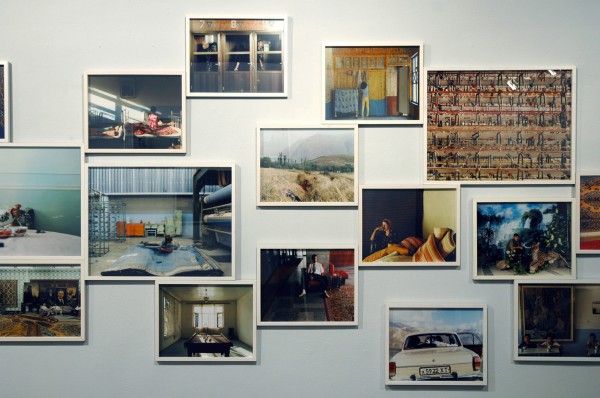
Tajikistan weaving by Miriam Rosen, ArtForum
For once, something has been gained in the translation--and there is a lot of translation going on in this remarkable series of images. To begin with, the title: What began in the mind of Sheffield-born, Paris-based photographer Rip Hopkins as "Tajikistan Weaving" became "Tadjikistan Tissages" for the purposes of this exhibition. The scatlike alliteration of the French version is already more compelling to the ear, but it is the subtle transformation of "weaving" into "weavings" (tissages) that serves to alert mind and eye to a multiplicity of possible readings. These emerge from Hopkins's translation of a journey of nearly two months into a photographic record of people and places in a country that was woven together in the '20s from bits and pieces of surrounding ethno-political entities and which is still in the process of being rewoven in the wake of the 1992-97 civil war.
Hopkins, too, has arrived at a kind of interweaving--of reportage, portraiture, painting, road movie, and autobiography. Consciously or unconsciously, his work has more in common with the carpets that sparked his interest in Tajikistan than with any documentary account. Among the technical "translations" this process has entailed is the shift from the panoramic camera Hopkins used in his earlier work as a photojournalist ("I got tired and cynical," he has said) to a medium-format Pentax complete with tripod (because "I wanted to be in control of the image") and from black-and-white to color ("People are generally disappointed when they find themselves reproduced in black and white"). The result is a much more studied sense of composition than before and a sensually understated treatment of color. Moving from one city, town, or village to another with contacts provided by people he met along the way, and notably the indispensable translators, Hopkins did not simply photograph the schoolteachers, travel agents, hotel owners, farm girls, orphans, carpet weavers, and others he encountered, but involved them in their own mise-enscene, so that, as he points out, they were the ones "who ultimately chose the image they wanted to convey of themselves."
Portraits? Not really: The subjects often look away from the camera, stand off to one side, turn their backs, or, in one case, absent themselves entirely from a domestic interior the better to display, instead, a refrigerator, a wall clock in the form of a giant wristwatch, and a television covered with a prayer carpet. In one particularly haunting image, almost a hybrid of photo and film, a Russian woman seen from behind is studying a painting on the wall of a popular history museum while her son blurs his way through the doorway beside her.
26 silver prints - 40*50cm
5 silver prints - 60*80cm
2 silver prints - 100*120cm
Glass + white wooden frame (widths 1.5-2.5cm)
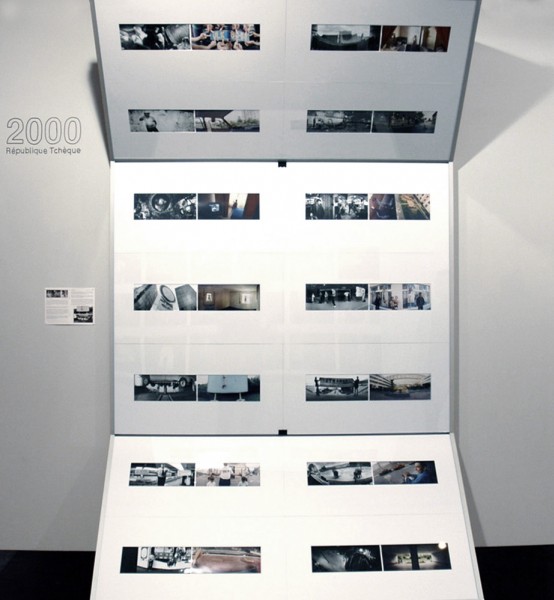
Land of Asylum, Land Of Exile, Roma Europe
A photographic portrayal of modern-day Roma
by Jean-François Joly and Rip Hopkins
They claimed that they came from "little Egypt". They were mysterious, intriguing. They became warriors, fortune tellers and court musicians to the greatest kings and queens in the land. The Roma led a life of splendour when they first arrived in Europe over 600 years ago. But during the last two centuries, fascination has given way to suspicion and resentment towards these people. With the growth of capitalism, they have been excluded from society and have become economically marginalised. Now numbering over six million, their history of migration has spread them throughout western and eastern Europe. In every country they are faced with ghettoization, high unemployment and violent discrimination.
Their distinct culture makes the Roma difficult for modern European society to accept : although solid, their identity contains none of the characteristics usually recognised in a nation such as a common history, language, religion or territory. Consequently they have been abandoned without the legal rights and with their needs ignored. The EEC countries have yet to agree on what legal status to grant them, but meanwhile their predicament is compounded by growing divisions among the Roma themselves. The are torn between the desire for citizenship within each country, and for collective recognition as a national minority spanning throughout Europe. The conflict has been exacerbated by a new wave of gypsy immigrants arriving from the east following the collapse of the Berlin Wall.
Recently, however, the Romany Union has been recognised by the EC as an organisation that represents Roma in Europe and, as far as possible, articulates their common grievances. With a new generation of intellectuals in the lead, they are finally taking the initiative and starting to mobilise in defence of their rights. The European media has consistently failed to confront the "gypsy problem". Our photographic investigation is therefore crucial to highlight their predicament. Through portraying their every day lives we will depict the difficulties that they face and the way they respond to them. Separately, we will follow and share the Roma’s daily life in the street, in the parking lots, in the schools and in the housing they have been attributed with the aim of settling them. The chosen countries of destination are Germany, France, Greece, Kosovo, Ireland, Czech Republic and Romania in order to show both their trans-national nature and the differences emerging between the communities. These seven countries will also indicate the varying political treatment received by the Roma and how their own culture compares to that of the locals. We have chosen these countries due to their specific behaviour and approach, culturally or politically, that they have adopted concerning their Roma communities. The photographic work performed in these different locations will constitute what is our vision of today’s Roma Europe.
Our portrayal will be presented through two complementary forms of photography. Using a panoramic format, in black and white and colour, Rip Hopkins will reveal the context and structure of the Roma’s lives. Jean-François Joly, taking black and white portraits with a 4x5 chamber, will explore the individuals more intimately. Our work will also present a series of portraits of the most significant figures in the political struggle for their rights. Though less splendid than the Roma of medieval Europe, the image of modern-day Roma is as dramatic and intriguing as ever.
14 silver prints - 12*60cm + cardboard mount - 40*80cm
Perspex + aluminium frame (width 2cm) with 5cm wall stand - 280*160cm
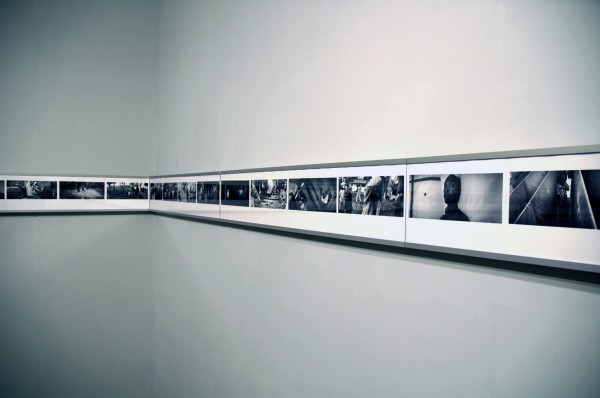
27 silver prints - 24*30cm
Glass + aluminium frame (width 2cm) with 5cm wall stand - 24*810cm
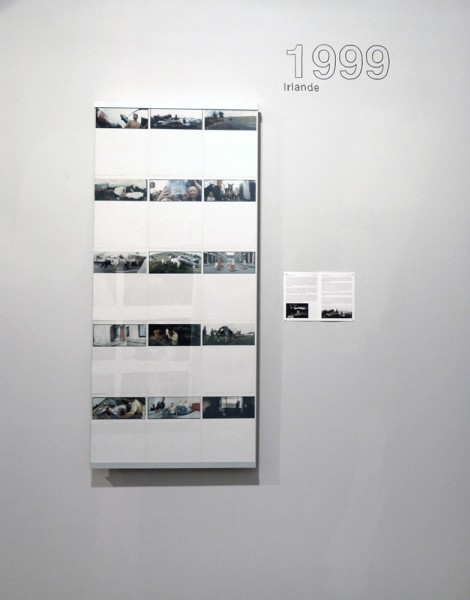
Land of Asylum, Land Of Exile, Roma Europe
A photographic portrayal of modern-day Roma
by Jean-François Joly and Rip Hopkins
They claimed that they came from "little Egypt". They were mysterious, intriguing. They became warriors, fortune tellers and court musicians to the greatest kings and queens in the land. The Roma led a life of splendour when they first arrived in Europe over 600 years ago. But during the last two centuries, fascination has given way to suspicion and resentment towards these people. With the growth of capitalism, they have been excluded from society and have become economically marginalised. Now numbering over six million, their history of migration has spread them throughout western and eastern Europe. In every country they are faced with ghettoization, high unemployment and violent discrimination.
Their distinct culture makes the Roma difficult for modern European society to accept : although solid, their identity contains none of the characteristics usually recognised in a nation such as a common history, language, religion or territory. Consequently they have been abandoned without the legal rights and with their needs ignored. The EEC countries have yet to agree on what legal status to grant them, but meanwhile their predicament is compounded by growing divisions among the Roma themselves. The are torn between the desire for citizenship within each country, and for collective recognition as a national minority spanning throughout Europe. The conflict has been exacerbated by a new wave of gypsy immigrants arriving from the east following the collapse of the Berlin Wall.
Recently, however, the Romany Union has been recognised by the EC as an organisation that represents Roma in Europe and, as far as possible, articulates their common grievances. With a new generation of intellectuals in the lead, they are finally taking the initiative and starting to mobilise in defence of their rights. The European media has consistently failed to confront the "gypsy problem". Our photographic investigation is therefore crucial to highlight their predicament. Through portraying their every day lives we will depict the difficulties that they face and the way they respond to them. Separately, we will follow and share the Roma’s daily life in the street, in the parking lots, in the schools and in the housing they have been attributed with the aim of settling them. The chosen countries of destination are Germany, France, Greece, Kosovo, Ireland, Czech Republic and Romania in order to show both their trans-national nature and the differences emerging between the communities. These seven countries will also indicate the varying political treatment received by the Roma and how their own culture compares to that of the locals. We have chosen these countries due to their specific behaviour and approach, culturally or politically, that they have adopted concerning their Roma communities. The photographic work performed in these different locations will constitute what is our vision of today’s Roma Europe.
Our portrayal will be presented through two complementary forms of photography. Using a panoramic format, in black and white and colour, Rip Hopkins will reveal the context and structure of the Roma’s lives. Jean-François Joly, taking black and white portraits with a 4x5 chamber, will explore the individuals more intimately. Our work will also present a series of portraits of the most significant figures in the political struggle for their rights. Though less splendid than the Roma of medieval Europe, the image of modern-day Roma is as dramatic and intriguing as ever.
15 silver prints - 17*24cm
Perspex + aluminium frame (width 2cm) with 5cm wall stand - 120*50cm
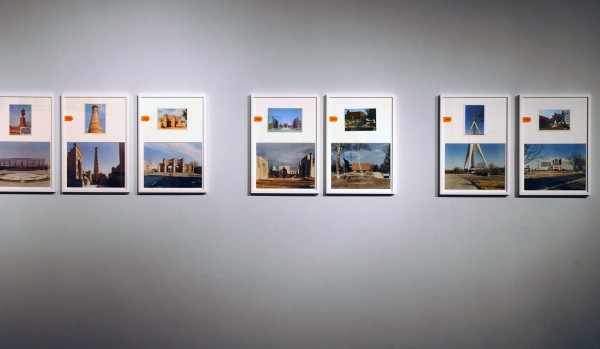
20 silver prints - 24*30cm + postcard / marie louise - 24*30cm
Glass + white wooden frame (width 1cm) + postcard mounted on white cardboard : frames - 50*32cm
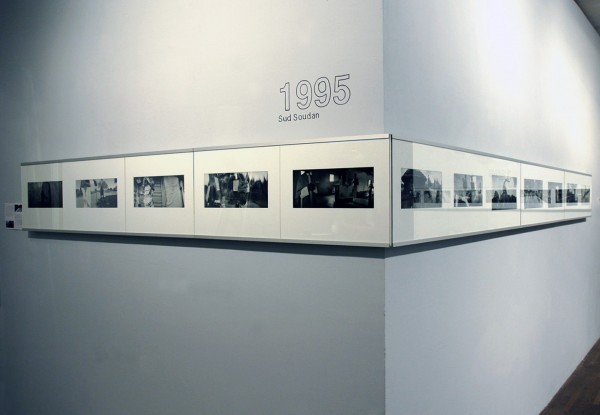
12 silver prints - 14,5*37cm + cardboard mount - 30*40cm
Glass + aluminium frame (width 2cm) with 5cm wall stand - 30*480cm
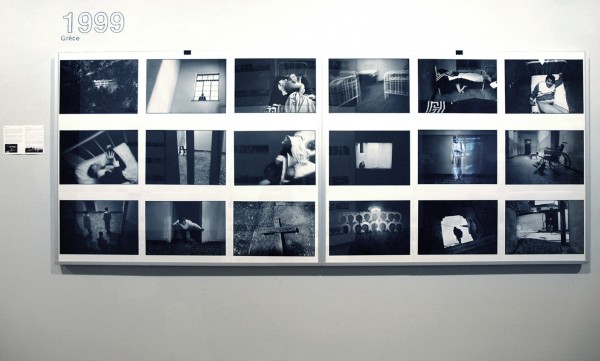
18 silver prints - 40*50cm
Perspex + aluminium frame (width 2cm) with 5cm wall stand - 120*300cm
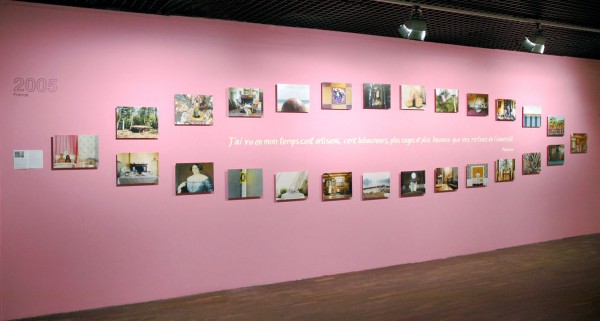
26 silver prints - 30*40cm
Mounted on aluminium (2mm thick) with 3cm wall stand

39 silver prints - 40*50cm
Mat aluminium frame (width 1cm)
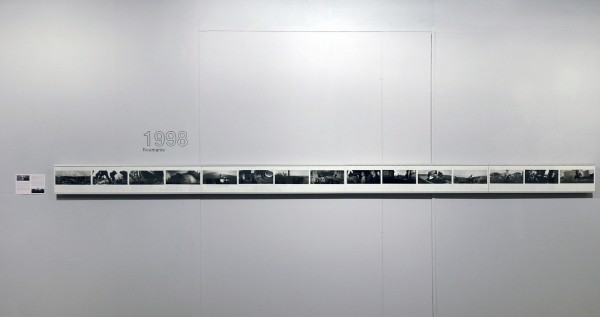
Land of Asylum, Land Of Exile, Roma Europe
A photographic portrayal of modern-day Roma
by Jean-François Joly and Rip Hopkins
They claimed that they came from "little Egypt". They were mysterious, intriguing. They became warriors, fortune tellers and court musicians to the greatest kings and queens in the land. The Roma led a life of splendour when they first arrived in Europe over 600 years ago. But during the last two centuries, fascination has given way to suspicion and resentment towards these people. With the growth of capitalism, they have been excluded from society and have become economically marginalised. Now numbering over six million, their history of migration has spread them throughout western and eastern Europe. In every country they are faced with ghettoization, high unemployment and violent discrimination.
Their distinct culture makes the Roma difficult for modern European society to accept : although solid, their identity contains none of the characteristics usually recognised in a nation such as a common history, language, religion or territory. Consequently they have been abandoned without the legal rights and with their needs ignored. The EEC countries have yet to agree on what legal status to grant them, but meanwhile their predicament is compounded by growing divisions among the Roma themselves. The are torn between the desire for citizenship within each country, and for collective recognition as a national minority spanning throughout Europe. The conflict has been exacerbated by a new wave of gypsy immigrants arriving from the east following the collapse of the Berlin Wall.
Recently, however, the Romany Union has been recognised by the EC as an organisation that represents Roma in Europe and, as far as possible, articulates their common grievances. With a new generation of intellectuals in the lead, they are finally taking the initiative and starting to mobilise in defence of their rights. The European media has consistently failed to confront the "gypsy problem". Our photographic investigation is therefore crucial to highlight their predicament. Through portraying their every day lives we will depict the difficulties that they face and the way they respond to them. Separately, we will follow and share the Roma’s daily life in the street, in the parking lots, in the schools and in the housing they have been attributed with the aim of settling them. The chosen countries of destination are Germany, France, Greece, Kosovo, Ireland, Czech Republic and Romania in order to show both their trans-national nature and the differences emerging between the communities. These seven countries will also indicate the varying political treatment received by the Roma and how their own culture compares to that of the locals. We have chosen these countries due to their specific behaviour and approach, culturally or politically, that they have adopted concerning their Roma communities. The photographic work performed in these different locations will constitute what is our vision of today’s Roma Europe.
Our portrayal will be presented through two complementary forms of photography. Using a panoramic format, in black and white and colour, Rip Hopkins will reveal the context and structure of the Roma’s lives. Jean-François Joly, taking black and white portraits with a 4x5 chamber, will explore the individuals more intimately. Our work will also present a series of portraits of the most significant figures in the political struggle for their rights. Though less splendid than the Roma of medieval Europe, the image of modern-day Roma is as dramatic and intriguing as ever.
15 silver prints - 24*30cm
Glass + aluminium frame (width 2cm) with 5cm wall stand - 24*450cm
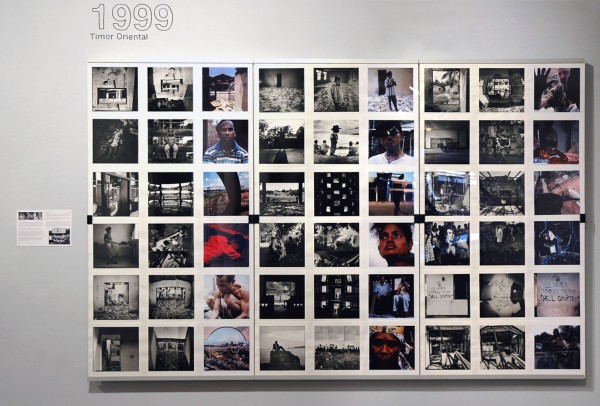
18 x 3 silver prints - 24*72cm
Perspex + aluminium frame (width 2cm) with 5cm wall stand - 144*216cm
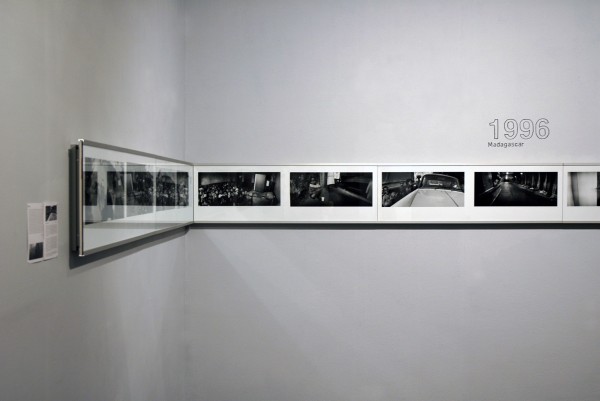
16 silver prints - 36*56cm
Glass + aluminium frame (width 2cm) with 5cm wall stand - 36*960cm
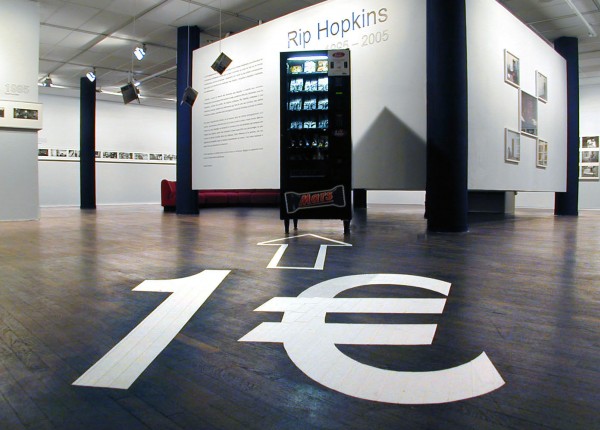
The book "Decade" (Editions Filigranes) is sold for 1 euro along with sweets in a vending machine.